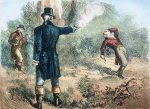The field of Products Liability is a subset of the Tort, only lower in fat. Products Liability was developed in the 1950's and served a number of purposes:
1) Attorney employment;
2) Allows redistribution of wealth to the logic-challenged.
To understand Products liability a fact-pattern may be helpful:
P works for E, a corporation. P has worked for E for twenty-two years. P's job is to remove cream from stale cream donuts so the cream can be reused in fresh donuts. To perform his job duties P must operate a sophisticated piece of machinery weighing well over 500lbs. The machine is equipped with an hydraulic scalpel as well as siphoning equipment.
One day, P's car breaks down and he must take the bus to work. He arrives fifteen minutes late and is told he'll have to make up that time at the end of his shift. During the last ten minutes of his shift, the machine jams. P carefully reads the sign on the machine: "WARNING, if machine jams turn machine off and contact the manufacturer or distributor. DO NOT attempt to repair machine due to the potential for serious injury! For God's Sake, make sure you never soak your feet in water while attempting to repair machine!" P, having been on his feet all day, fills a bucket with warm water to soaks his feet. While soaking his feet, P sees a panel secured to the machine by 45 bolts. A sticker on the panel says, "DO NOT remove panel under any circumstances. Don't say we didn't warn you!" P reads the sticker four or five times. Additionally, P's employer has used duct tape to secure a note to Plaintiff's forehead. The note reads, "If machine breaks, don't do anything. And your wife called, something about the rash not being contagious."
P spends the next five hours soaking his feet and trying every method available to remove the panel. His co-workers tell him to go home and let the shift supervisor call the manufacturer. P ignores them and finally gets the panel off the machine. P immediately sees that a donut is jammed between two sharp, metal parts moving slightly faster than an airplane propeller at full throttle.
Hours later P is recovering in the hospital from a mangled left hand and severe electrical shock.
Determining what causes of action P has and against which defendants will help you grasp the theories underlying Products Liability. Under current Products Liability theories, P has approximately 276 causes of action against 93 potential defendants. Well discuss a few of those below.
Defendant(s) No. One & Two: Automobile Manufacturer and Seller
P has causes of action in Product Liability and Warranty against those who manufactured and sold his car. If the car had not broken down, P would have been on time and not present at his employment when the machine jammed.
Defendant(s) Three, Four & Five: The Designer, Manufacturer and Distributor of the machine
This is a no-brainer. P will sue all three for Product Liability, Failure to Warn, Strict Liability and simple negligence. The design defect allowed the machine to jam. The manufacturer did not place adequate safeguards on the machine. The access panel was not adequately secured against someone attempting to remove it as 70 or 80 bolts should have been used to secure the panel. Finally, the defendants should have placed more warning signs on the machine in less ambiguous language.
Defendant(s) Six: Employer
If P's State allows suits by employees against employers then P has a claim against his employer for negligent hiring practices. To wit: If the employer had not hired P then P would never have been hurt.
Defendant(s) Seven& Eight: Water Bucket Manufacturer & Seller
The manufacturer and seller of the bucket P used to soak his feet failed to place adequate warnings on the bucket advising P not to soak his feet in the bucket while using electrical equipment.
Defendant(s) Nine: P's School District
P has a claim for educational malpractice against his School District, which gave him a substandard education and failed to prepare him to deal with life.
We hope that this example has made the field of Products liability come to life so you can better understand the complexities surrounding this growing legal field.

